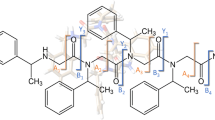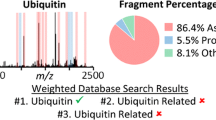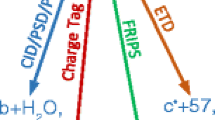Abstract
The fragmentation behavior of a set of model peptides containing proline, its four-membered ring analog azetidine-2-carboxylic acid (Aze), its six-membered ring analog pipecolic acid (Pip), an acyclic secondary amine residue N-methyl-alanine (NMeA), and the D stereoisomers of Pro and Pip has been determined using collision-induced dissociation in ESI-tandem mass spectrometers. Experimental results for AAXAA, AVXLG, AAAXA, AGXGA, and AXPAA peptides are presented, where X represents Pro, Aze, Pip, or NMeA. Aze- and Pro-containing peptides fragment according to the well-established “proline effect” through selective cleavage of the amide bond N-terminal to the Aze/Pro residue to give yn + ions. In contrast, Pip- and NMA-fragment through a different mechanism, the “pipecolic acid effect,” selectively at the amide bond C-terminal to the Pip/NMA residue to give bn + ions. Calculations of the relative basicities of various sites in model peptide molecules containing Aze, Pro, Pip, or NMeA indicate that whereas the “proline effect’ can in part be rationalized by the increased basicity of the prolyl-amide site, the “pipecolic acid effect” cannot be justified through the basicity of the residue. Rather, the increased flexibility of the Pip and NMeA residues allow for conformations of the peptide for which transfer of the mobile proton to the amide site C-terminal to the Pip/NMeA becomes energetically favorable. This argument is supported by the differing results obtained for AAPAA versus AA(D-Pro)AA, a result that can best be explained by steric effects. Fragmentation of pentapeptides containing both Pro and Pip indicate that the “pipecolic acid effect” is stronger than the “proline effect.”

ᅟ






Similar content being viewed by others
References
Angel, T.E., Aryal, U.K., Hengel, S.M., Baker, E.S., Kelly, R.T., Robinson, E.W., Smith, R.D.: Mass spectrometry-based proteomics: existing capabilities and future directions. Chem. Soc. Rev. 41, 3912–3928 (2012)
Roepstorff, P.: Mass spectrometry based proteomics, background, status, and future needs. Protein Cell 3, 641–647 (2012)
Sabido, E., Selevsek, N., Aebersold, R.: Mass spectrometry-based proteomics for systems biology. Curr. Opin. Biotechnol. 23, 591–597 (2012)
Kelleher, N.L.: Status of mass spectrometry-based proteomics and metabolomics in basic and translational research. Biochemistry 52, 3794–3796 (2013)
Zahang, Y., Fonslow, B.R., Shan, B., Baek, M.-C., Yates, J.R.: Protein analysis by shotgun/bottom-up proteomics. Chem. Rev. 113, 2343–2394 (2013)
Paizs, B., Suhai, S.: Fragmentation pathways of protonated peptides. Mass Spectrom. Rev. 24, 508–548 (2004)
Kapp, E.A., Schutz, F., Reid, G.E., Eddes, J.S., Moritz, R.L., O'Hair, R.A.J., Speed, T.P., Simpson, R.J.: Mining a tandem mass spectrometry database to determine the trends and global factors influencing peptide fragmentation. Anal. Chem. 75, 6251–6264 (2003)
Cox, K.A., Gaskell, S.J., Morris, M., Whiting, A.: Role of the site of protonation in the low-energy decompositions of gas-phase peptide ions. J. Am. Soc. Mass Spectrom. 7, 522–531 (1996)
Dongre, A.R., Jones, J.L., Somagyi, A., Wysocki, V.H.: Influence of peptide composition, gas-phase basicity, and chemical modification on fragmentation efficiency: evidence for the mobile proton model. J. Am. Chem. Soc. 118, 8365–8374 (1996)
Wysocki, V.H., Tsaprailis, G., Smith, L.L., Breci, L.A.: Mobile and localized protons: a framework for understanding peptide dissociation. J. Mass Spectrom. 35, 1399–1406 (2000)
Eng, J.K., McCarmack, A.L., Yates III, J.R.: An approach to correlate tandem mass spectral data of peptides with amino acid sequences in a protein database. J. Am. Soc. Mass Spectrom. 5, 976–989 (1994)
Perkins, D.N., Pappin, D.J.C., Creasy, D.M., Cottrell, J.S.: Probability-based protein identification by searching sequence databases using mass spectrometry data. Electrophoresis 20, 3551–3567 (1999)
Craig, R., Beavis, R.C.: TANDEM: Matching proteins with tandem mass spectra. Bioinformatics 20, 1466–1467 (2004)
Elias, J.E., Gibbons, F.D., King, O.D., Roth, F.P., Gygi, S.P.: Intensity-based protein identification by machine learning from a library of tandem mass spectra. Nat. Biotechnol. 22, 214–219 (2004)
Li, W., Ji, L., Goya, J., Tan, G., Wysocki, V.H.: SQID: an intensity-incorporated protein identification algorithm for tandem mass spectrometr. J. Proteome Res. 10, 1593–1602 (2011)
Schwartz, B.L., Bursey, M.M.: Some proline substituent effects in the tandem mass spectrum of protonated pentaalanine. Biol. Mass Spectrom. 21, 92–96 (1992)
Loo, J.A., Edmonds, C.A., Smith, R.D.: Tandem mass spectrometry of very large molecules. 2. Dissociation of multiply charged proline-containing proteins from electrospray ionization. Anal. Chem. 65, 425–438 (1993)
Yu, W., Vath, J.E., Huberty, M.C., Martin, S.A.: Identification of the facile gas-phase cleavage of the Asp-Pro and Asp-Xxx peptide bonds in matrix-assisted laser desorption time of flight mass spectrometry. Anal. Chem. 65, 3015–3023 (1993)
Vaisar, T., Urban, J.: Probing the proline effect in CID of protonated peptides. J. Mass Spectrom. 31, 1185–1187 (1996)
Schaaff, T.G., Cargile, B.J., Stephanson Jr., J.L., McLuckey, S.A.: Ion trap activation of the (M + 2H)2+ and (M + 17H)17+ ions of human hemoglobin b-chain. Anal. Chem. 72, 899–907 (2000)
Tsaprailis, G., Somogyi, A., Nikolaev, E.N., Wysocki, V.H.: Refining the model for selective cleavage at acid residues in arginine-containing protonated peptides. Int. J. Mass Spectrom. 195/196, 467–479 (2000)
Sullivan, A.G., Brancia, F.L., Tyldesley, R., Bateman, R., Sidhu, K., Hubbard, S.J., Oliver, S.G., Gaskell, S.J.: The exploitation of selective cleavage of singly protonated peptide ions adjacent to aspartic acid residues using a quadrupole orthogonal time-of-flight mass spectrometer equipped with a matrix-assisted laser desorption/ionization source. Int. J. Mass Spectrom. 210/211, 665–676 (2001)
Huang, Y., Wysocki, V.H., Tabb, D.L., Yates, J.R.I.: The influence of histidine on cleavage c-terminal to acidic residues in doubly protonated tryptic peptides. Int. J. Mass Spectrom. 291, 233–244 (2002)
Breci, L.A., Tabb, D.L., Yates, J.R.I., Wysocki, V.H.: Cleavage N-terminal to proline: analsis of a database of peptide tandem mass spectra. Anal. Chem. 75, 1963–1971 (2003)
Grewal, R.N., El Aribi, E.H., Harrison, A.G., Siu, K.W.M., Hopkinson, A.C.: Fragmentation of protonated tripeptides: the proline effect revisited. J. Phys. Chem. B 108, 4899–4908 (2004)
Huang, Y., Triscari, J.M., Tseng, G.C., Pasa-Tolic, L., Lipton, M.S., Smith, R.D., Wysocki, V.H.: Statistical characterization of the charge state and residue dependence of low-energy CID peptide dissociation patterns. Anal. Chem. 77, 5800–5813 (2005)
Harrison, A.G., Young, A.B..: Fragmentation reactions of deprotonated peptides containing proline. The proline effect. J. Mass Spectrom. 40, 1173–1186 (2005)
Unnithan, A.G., Myer, M.J., Veale, C.J., Dannell, A.S.: MS/MS of protonated polyproline peptides; the influence of N-terminal protonation on dissociation. J. Am. Soc. Mass Spectrom. 18, 2198–2205 (2007)
Huang, Y., Tseng, G.C., Yuan, S., Pasa-Tolic, L., Lipton, M.S., Smith, R.D., Wysocki, V.H.: A data mining scheme for identifying peptide structural motifs responsible for different MS/MS fragmentation intensity patterns. J. Proteome Res. 7, 70–79 (2008)
Bleiholder, C., Suhai, S., Harrison, A.G., Paizs, B.: Towards understanding the tandem mass spectra of protonated oligopeptides. 2. The proline effect in collision-induced dissociation of protonated Ala-Ala-Xxx-Pro-Ala (Xxx = Ala, Ser, Leu, Val, Phe, and Trp). J. Am. Soc. Mass Spectrom. 21, 1032–1039 (2011)
Zhang, Q., Perkins, B., Tan, G., Wysocki, V.H.: The role of proton bridges in selective cleavage of Ser-, Thr-, Cys-, Met-, Asp-, and Asn-containing peptides. Int. J. Mass Spectrom. 300, 108–117 (2011)
McGee, W.M., McLuckey, S.A.: The ornithine effect in peptide cation dissociation. J. Mass Spectrom. 48, 856–861 (2013)
Roepstorff, P.: Proposal for a common nomenclature for sequence ions in mass spectra of peptides. Biomed. Mass Spectrom. 11, 601 (1984)
Gucinski, A.C., Chamot-Rooke, J., Steinmetz, V., Somogyi, A., Wysocki, V.H.: Influence of N-terminal residue composition on the structure of proline-containing b2 + ions. J Phys. Chem. A 117, 1291–1298 (2013)
Kuntz, A.F., Boynton, A.W., David, G.A., Colyer, K.E., Poutsma, J.C.: Proton affinities of proline analogs using the kinetic method with full entropy analysis. J. Am. Soc. Mass Spectrom. 13, 72–81 (2002)
Tsang, Y., Wong, C.C.L., Wong, C.H.S., Cheng, J.M.K., Ma, N.L., Tsang, C.W.: Proton and potassium affinities of aliphatic and N-methylated aliphatic a amino acids: effect of alkyl chain length on relative stability of K+-bound Zwitterionic complexes. Int. J. Mass Spectrom. 316/318, 273–283 (2012)
Chan, W.C., White, P.D.: Fmoc Solid Phase Peptide Synthesis: A Practical Approach. Oxford University Press, New York (2000)
Millam, J.M., Daniels, A.D., Kudin, K.N., Strain, M.C., Farkas, O., Tomasi, J., Barone, V., Cossi, M., Cammi, R., Mennucci, B., Pomelli, C., Adamo, C., Clifford, S., Ochterski, J., Petersson, G.A., Ayala, P.Y., Cui, Q., Morokuma, K., Malick, D.K., Rabuck, A.D., Raghavachari, K., Foresman, J.B., Cioslowski, J., Ortiz, J.V., Baboul, A.G., Stefanov, B.B., Liu, G., Liashenko, A., Piskorz, P., Komaromi, I., Gomperts, R., Martin, R.L., Fox, D.J., Keith, T., Al-Laham, M.A., Peng, C.Y., Nanayakkara, N., Challacombe, M., Gill, P.M.W., Johnson, B., Chen, W., Wong, M.W., Andres, J.L., Gonzalez, C., Head-Gordon, M., Replogle, E.S., Pople, J.A.: Gaussian 98 ver. A.9. Gaussian, Inc, Pittsburgh (1998)
PCModel Serena Software (2006)
Becke, A.D.: Density functional thermochemistry. III. The role of exact exchange. J. Chem. Phys. 98, 5648–5652 (1993)
Lee, C., Yang, W., Parr, R.G.: Development of the Colle-Salvetti correlation energy formula into a functional of the electron density. Phys. Rev. B 37, 785–789 (1988)
Hunter, E.P., Lias, S.G.: Evaluated gas phase basicities and proton affinities of molecules: an update. J. Phys. Chem. Ref. Data 27, 3–656 (1998)
Vaisar, T., Urban, J.: Low-energy collision-induced dissociation of protonated peptides. Importance of an oxazolone formation for a peptide bond cleavage. Eur. Mass Spectrom. 4, 359–364 (1998)
Acknowledgments
This work was supported by the National Science Foundation, J.C.P.: (CAREER:0348889 and CHE:0911244) and the National Institutes of Health, V.H.W. (GM R0151387). Additional support was contributed by the Camille and Henry Dreyfus Foundation through the Henry Dreyfus Teacher-Scholar Award (J.C.P.) and the College of William and Mary. The authors thank Marriah Binek and Katie Henke for contributions to the project.
Author information
Authors and Affiliations
Corresponding author
Rights and permissions
About this article
Cite this article
Raulfs, M.D.M., Breci, L., Bernier, M. et al. Investigations of the Mechanism of the “Proline Effect” in Tandem Mass Spectrometry Experiments: The “Pipecolic Acid Effect”. J. Am. Soc. Mass Spectrom. 25, 1705–1715 (2014). https://doi.org/10.1007/s13361-014-0953-5
Received:
Revised:
Accepted:
Published:
Issue Date:
DOI: https://doi.org/10.1007/s13361-014-0953-5




